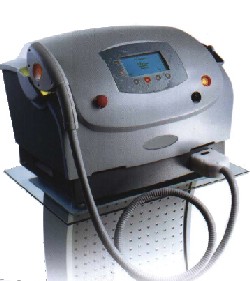|
|
|
Skin rejuvenation is one of several options available in the Choices Anti-Aging Program. |
Low Startup, Tech-level Service
Perhaps the program's greatest potential appeal among physicians is that, after their initial investment, they really don't have to do anything to promote or deliver the aesthetic services. With the Casebeer Turn Key Aesthetic System, the company provides the technology, training, and in-house marketing materials to get the program up and running. The services are performed by a technician, freeing the ophthalmologist to do what he does best—treat eyes. According to state law, the aesthetic treatments may be delivered by a trained technician, a registered nurse, or a physician's assistant.
Technically, the treatments mostly are delivered by a derivative of the intense pulsed-light systems common to dermatology, in this case what is known as advanced fluorescent technology (AFT). Manufactured by the Israeli company Orion, the so-called Harmony system is a high-powered light source that converts unused UV light into peak wavelengths suited to treating specific indications. Its UVB applications include various forms of leukoderma (depigmentation), acne scars, traumatic and surgical scars, hypopigmentation following laser resurfacing or chemical peels, psoriasis, vitiligo, and atopic dermatitis.
The Harmony system also comes with an Nd:YAG laser for treating vascular lesions such as hemangiomas, port-wine stains and leg veins. Its Q-switched Nd:YAG treatment head removes tattoos and concentrated pigmented lesions, while a long-pulsed Nd:YAG setting is best suited for coagulation and homeostasis of vascular lesions and soft tissue, including telangiectasias and reticular leg veins, as well as non-ablative treatment of facial wrinkles. Also included is a light emitting diode unit called Max-7, manufactured by Flip-4 Co., of Montreal, that delivers cold light to stimulate and redirect cutaneous DNA to rehabilitate the skin. A cooling unit made by the Swedish company Zimmer precludes the need for anesthesia in most cases. Most indications require multiple treatment sessions. Postoperative healing is relatively quick and painless. To date, the procedures delivered by the technicians at the five practices that have incorporated the Choices system have been virtually complication-free.
|
|
|
The Harmony system comes with an Nd:YAG laser to treat vascular lesions. |
Rounding out its clinical services, the Choices program includes a line of branded cosmeceuticals (cosmetic pharmaceuticals), including sunblockers for the first week or so following treatment, during which patients are advised to avoid sun exposure and wear a brimmed hat when outdoors. Dr. Casebeer and his colleagues are now exploring the feasibility of incorporating nutraceuticals (antioxidant vitamin and mineral supplements) into the program.
A Familiar Market
An early pioneer and promoter of refractive surgery, Dr. Casebeer possesses the requisite knowledge and experience to devise and market a skin-treatment program targeted largely toward the baby boomer market. In a sense, he's been here before.
"The demographics of aesthetics and refractive surgery appear to be exactly the same—[people] who have some desire to improve themselves," Dr. Casebeer says. "Every refractive practice has thousands of aesthetic patients coming in and out, yet it never dawns on them that their ophthalmologist would do [skin treatment]. The idea is to stimulate new aesthetic clients right out of the refractive practice." A patient who trusts the doctor with her eyes theoretically is likely to extend that trust when it comes to aesthetic skin treatments.
Dr. Casebeer is careful to define the Choices program as "pure aesthetics" to distinguish it from services provided by dermatologists and plastic surgeons. Nonetheless, this clearly introduces overlap from one subspecialty to the next, and Dr. Casebeer is aware of that. "I don't want another political battle," he says.
Depending on the range of services and technology desired, an ophthalmologist may invest between $88,000 and $126,000 to incorporate the Choices program. It's a one-time investment; there are no per-procedure fees. Most of that investment applies to the technology, but also includes in-house training and marketing materials.
Patient fees are highly variable. A patient who wishes, for example, to undergo skin rejuvenation of her entire face may pay a fee up to $1,400. Hair reduction—a service not only for women but also for men wishing, for example, to be rid of simian hair on the back—might command a fee of $600 to $700. Some minor treatments may cost the patient just $100 or $150. The various treatments can be delivered in about 50 minutes in the case of microdermabrasion, 30 minutes for vascular lesions, 60 minutes for hair reduction, and 30 minutes for collagen stimulation, according to company literature. A practice's yearly net income from the various aesthetic skin treatments may range from $212,000 to $240,000, according to the company's calculations.
After decades of lectures and published papers in the ophthalmologic arena, Dr. Casebeer's name alone is one of the company's cardinal intangible assets. "I'm happy to say that people trust me," he says. Two other principals round out the company's investors, while a recently engaged sales force aims to expand the company's market reach. (Previously, Dr. Casebeer and an assistant performed all of the company's activities based in Divide, Mont.) "Our goal is to bring complication-free—though we won't ever actually use that word—quality, affordable aesthetics to the public by way of licensed medical practitioners, with an emphasis at the start on ophthalmology," Dr. Casebeer says. "The appeal is the completeness of the package. In a year or two there will be every kind of [aesthetic skin treatment] system you ever heard of."
For information, contact Dr. Casebeer at jccasebeer@aol.com or call (406) 267-3107.





